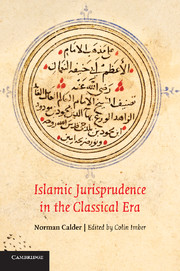Book contents
- Frontmatter
- Contents
- Editor's Preface
- Introduction
- 1 The Ḥanafī Law on Fornication
- 2 Nawawī and the Typologies of Fiqh Writing
- 3 Scholars, Muftis, Judges and Secular Power: The Need for Distinctions
- 4 The Social Function of Fatwas
- Afterword: Scholarly Priorities and Islamic Studies: The Reviews of Norman Calder (Robert Gleave)
- Principal Sources Used
- Index
4 - The Social Function of Fatwas
Published online by Cambridge University Press: 04 May 2010
- Frontmatter
- Contents
- Editor's Preface
- Introduction
- 1 The Ḥanafī Law on Fornication
- 2 Nawawī and the Typologies of Fiqh Writing
- 3 Scholars, Muftis, Judges and Secular Power: The Need for Distinctions
- 4 The Social Function of Fatwas
- Afterword: Scholarly Priorities and Islamic Studies: The Reviews of Norman Calder (Robert Gleave)
- Principal Sources Used
- Index
Summary
Introduction
For each of the three functionaries of the law there is a corresponding body of literature which exemplifies their activities. For the academic jurist, it is the literary genres of furūʿ al-fiqh and (to a lesser extent) usūl al-fiqh. For the judge, it is the court records (sijills). The latter had a practical importance as a record of decisions and judgements, but had no direct significance as an articulation of divine law; they did not constitute precedents; they were not a part of the training of jurists or judges. Works of furūʿ, on the other hand, were a record of the madhhab, of ikhtilāf and of the arguments that grew out of these; they were the measure of the law, and the prime means of education for judges and jurists. They were also the major component of a ‘liberal’ education, in so far as that was known to pre-modern Islamic societies. The literary products associated with the mufti were the fatwa, the fatwa collection and the analytic works, or manuals of conduct (adab al-muftī) which explained and justified the mufti's task. This chapter is concerned with the fatwa, its functions and its transformations.
- Type
- Chapter
- Information
- Islamic Jurisprudence in the Classical Era , pp. 167 - 200Publisher: Cambridge University PressPrint publication year: 2010
- 1
- Cited by

